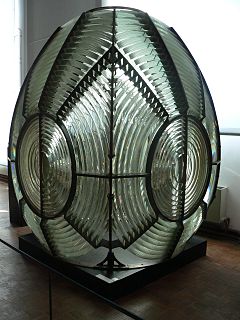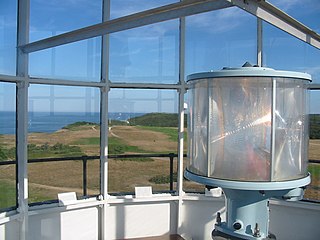 W
WAn aerobeacon is a light assembly used to create a fixed or flashing signal visible over long distances. It consists of a high intensity electric lamp mounted with a focusing device in a cylindrical housing, which usually is rotated on a vertical axis by an electric motor. The sweep of the narrow beam thus produced gives the flashing effect. Aerobeacons were originally developed for aviation use, mostly as aerodrome beacons, but they also saw extensive use in lighthouses. They were far less expensive to manufacture and maintain than classic glass Fresnel lenses, and much more durable; they could be mounted and exposed to the weather. Historic models include the DCB-24, which used a single parabolic reflector; the DCB-224, a double-beamed version of the DCB-24; and the DCB-36, which used a system of plastic Fresnel type lenses. Manufacturers included Carlisle & Finch in Cincinnati and the Crouse-Hinds Company in Syracuse, New York. Aerobeacons have replaced fragile glass Fresnel lenses in many lighthouses and are still widely used in other applications.
 W
WThe Argand lamp is a type of oil lamp invented in 1780 by Aimé Argand. Its output is 6 to 10 candelas, brighter than that of earlier lamps. Its more complete combustion of the candle wick and oil than in other lamps required much less frequent trimming of the wick.
 W
WAn automatic lamp changer is a device used to ensure that a navigational light such as a marine lighthouse or aero beacon stays lit even if a bulb burns out. Numerous types exist. The common design elements are an array of two or more lamps, installed on a mounting which can rotate to various positions. Each position brings a different lamp into the focal point of an optical assembly. Since signal and navigational lights use sophisticated optics to focus the beam, lampchangers are designed to position the new bulb at the focal point with high precision. The device automatically detects when the currently active lamp has ceased to function and moves the next lamp into place.
 W
WA bird-cage lantern was the style of lantern common to American lighthouses in the early years of the nineteenth century. The lanterns received their name because of their appearance; they are shaped like wire bird cages.
 W
WThe Carcel lamp was an efficient lighting device used in the nineteenth century for domestic purposes and in France as the standard measure for illumination.
 W
WA Dalén light is a light produced from burning of carbide gas (acetylene), combined with a solar sensor which automatically operates the light only during darkness.
 W
WA foghorn or fog signal is a device that uses sound to warn vehicles of navigational hazards such as rocky coastlines, or boats of the presence of other vessels, in foggy conditions. The term is most often used in relation to marine transport. When visual navigation aids such as lighthouses are obscured, foghorns provide an audible warning of rock outcrops, shoals, headlands, or other dangers to shipping.
 W
WA Fresnel lens is a type of composite compact lens developed by the French physicist Augustin-Jean Fresnel (1788–1827) for use in lighthouses. It has been called "the invention that saved a million ships."
 W
WHyper-radial or hyperradiant Fresnel lenses are Fresnel lenses used in lighthouses. They are larger than "first-order" lenses, having a focal length (radius) of 1330 mm. The idea was mentioned by Thomas Stevenson in 1869 and first proposed by John Richardson Wigham in 1872, and again proposed by Thomas Stevenson in 1885.
 W
WA lens lantern is a small, self-contained lamp structure which may sometimes be used to serve as a lighthouse. Unlike a regular Fresnel lens, the lantern requires no housing to protect it from the weather; its glass sides would refract and magnify the light in the same fashion as would the lens. Lens lanterns were popular alternatives to lighthouses in the nineteenth century; they required less care, were cheaper to erect, and could be fairly easily placed.
 W
WA light characteristic is a graphic and text description of a navigational light sequence or colour displayed on a nautical chart or in a Light List with the chart symbol for a lighthouse, lightvessel, buoy or sea mark with a light on it. The graphic indicates how the real light may be identified when looking at its actual light output type or sequence. Different lights use different colours, frequencies and light patterns, so mariners can identify which light they are seeing.
 W
WThe VRB-25 is a lighthouse optical system designed and built by Vega Industries Ltd. in Porirua, New Zealand. It was originally designed in 1993-95 with the assistance of the United States Coast Guard to meet USCG requirements for a robust mechanism requiring minimum maintenance. It has become the Coast Guard's standard 12 volt rotating beacon. The company's literature says there are more than 400 installations worldwide. More than a quarter of the active lighthouses in Maine have one installed.